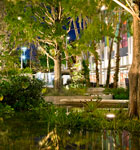1929: Austin Lumber founded
Shortly after the stock market crash of 1929, William Willhoite starts what becomes a set of three building industry-related companies, which are ultimately divvied up among his sons. These businesses are just part of how the Willhoite family initially uses its land in the eastern part of Austin, Texas. There are cattle and sheep and a sustenance garden on the property as well. “They were so broke they didn’t know it,” Culin jokes.
1941: A second generation takes the reins
William Willhoite dies the day Pearl Harbor is attacked, effectively leaving the business to his son Bernie Willhoite. As the war effort grows, many building materials are rationed, but using business savvy and capitalizing on its close proximity to a railroad track, Austin Lumber becomes the sole source of cement in Austin.
1945—1964: Divide and conquer
Bernie and his brothers split the businesses among themselves during the war: one brother becomes an architect, another goes into metal supplies, and Bernie and another brother keep the commercial-building-supply companies. After the war, Bernie also builds 700-square-foot houses for employees of the slaughterhouse industry nearby. The homes sell for $2,850, and Bernie helps finance them by holding property deeds as the lender to the homeowners.
Family members get little rest while running the business. Their weekends include retrieving lumber in East Texas or chain link fencing in Houston, and children in the Willhoite clan help unload inventory in the mornings before going to school.
1965—1995: Culin learns the ropes
Culin’s father, Don, purchases the lumberyard from Bernie, his father, in 1965. As a child, Culin begins to learn company operations. She studies retail buying, business math, and marketing in Dallas and Austin and then goes to work for the company in 1985. She is given full management responsibilities in 1989 and takes ownership by purchasing the firm from her father in 1995. She founds the East Austin Business Owners Association that same year.
2005: Fire and legal battles
Culin is unable to insure her buildings because of the age of the structures and the neighborhood in which they are located. On January 1, 2005, neighborhood children playing with firecrackers start a fire that burns five of the seven buildings to the ground, a loss that includes a mill, a truck, a forklift, and all inventory. Culin has to spend an additional $60,000 on a frivolous lawsuit defense related to the fire, which she eventually wins, and she battles a computer hacker who tries to steal the company name—all this while facing the daunting choice of rebuilding or closing down the company. “I did not want to be the one who quit the family business,” Culin says of her perseverance. “My daddy was tough on me, and he taught me to survive.”

2006—Present: Reinvention and recession
Post-fire, Culin decides to take the company in a green direction. She self-finances, rebuilding a retail hardware store, an office, and two enclosed warehouses—all of them made of fire-resistant metal and concrete—and she expands to offer a decidedly green line of products.
Working in Austin, which is famous as a progressive area of the Lone Star State, Culin is already familiar with a green sensibility. “When I wasn’t sure if my business would survive, I taught courses on green products at Austin Community College and was certified to teach on FSC lumber,” she says. “I decided it would be our point of differentiation to offer eco-friendly products.”
The company now supplies businesses such as Texas Roofing, a major local contractor that leans on Culin’s green expertise for projects such as several buildings at Texas A&M University (above). Those new structures open in August 2008, just one month before the financial meltdown that year. Culin acknowledges it has since been a challenge. But, she says, “I’m still here. I love what I do.” ABQ


